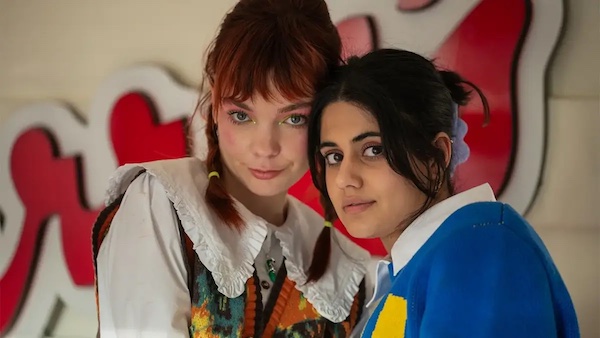Television Review: “Heartbreak High,” Season Two — A Distinct Letdown
By Sarah Osman
The Aussie teen soap falls victim to the dreaded sophomore slump.

(l to r) Harper (Asher Yasbincek), Quinni (Chloe Hayden), Darren (James Majoos), and Amerie (Ayesha Madon) in Heartbreak High. Photo: Netflix
Euphoria has been touted as the pinnacle of Gen Z high school shows but, ironically, it doesn’t air on the undisputed valhalla for the genre: Netflix. Over the years, the company has produced some surprisingly brilliant takes on what is like for what many believe to be the most nihilistic generation ever. In that competition, one little Aussie dramedy drew comparisons to some of the heavy hitters, Sex Education, Heartstopper, and Never Have I Ever. Alas, now in its second season, Heartbreak High didn’t undergo the same creative growth as the others — it’s hit the dreaded sophomore slump.
A reboot of the ’90s series of the same name, the first season of Heartbreak High took on thorny but essential issues through a thoughtful and distinctly Australian lens: racial tensions, wealth disparity, gender identity, and romantic relationships. Malaki (Thomas Weatherall), the cute new guy, is subjected to police brutality because he’s Aboriginal. Quinni (Chloe Hayden) is on the autism spectrum; throughout the first season we see how this affects her love life as well as her everyday existence. Darren (James Majoos), Quinni’s non-binary bestie, struggles to find romance while dealing with a rocky relationship with his confused albeit well-meaning father. The first season also explored more conventional teen issues, such as friendship breakups.
Of course, to do justice to substantial topics, the writing must be astute, and it was in season one. Surprisingly, this time around intelligence has been pushed to the side — perhaps for the sake of formula appeal. What had been an exploration of toxic masculinity in Australian culture has given way to a season-long cornball mystery, ala Riverdale. Someone is targeting Amerie (Ayesha Madon), but the writers don’t make us care who it is — a series that once deftly handled police brutality is now floundering in ham-fisted stalker territory. A new character, Rowan (Sam Rechner), initially serves as a crush for Malaki, who is questioning his sexuality. But the figure is quickly turned into a facile plot device. A new group of teens — determined to preserve their virginity — come off as stereotypes. That is a shame because this subplot could have been illuminating if handled more delicately.

(l to r) Quinni (Chloe Hayden) and Amerie (Ayesha Madon) in Heartbreak High. Photo: Netflix
The most disappointing shift downward concerns Quinni. She’s reduced to playing detective, eventually behaving in ways that don’t make any sense given what we have learned about the character. More unfortunate is how she reverts to cliche autism behavior, such as becoming extremely blunt — a trait Quinni never had before. Why the dumbed-down shift in perspective? To give the character agency? It is a deeply disappointing move since Quinni was one of the most complex and realistic portraits of autism on TV.
Not all of season two is so dispiriting. The series’s fashion and makeup remain on-point: its fabulous Gen Z looks rival Euphoria’s. Spider (Bryn Chapman Parish), a one-note jerk in the first season, is fleshed out. It turns out that he is far more caring than he lets on. Missy (Sherry Lee-Watson), a secondary character early on, has been bumped into a regular by way of an endearing relationship with Spider. Madon remains as charming as ever as Amerie; despite her best efforts to get her life together, she continues to make mistakes. And, while some of the new superficial plotlines are unbelievable, they are highly amusing, like when the students eat shrooms during a camping trip.
At first, Heartbreak High seemed to know where it was going. But, like its increasingly aimless characters, the series needs to figure out a direction with a meaningful destination. The series should embrace its originality — why become a diluted copycat of others? As Oscar Wilde once said, “Be yourself; everyone else is taken.” A third season of Heartbreak High would be welcome — if the writers have the wisdom to keep this in mind.
Sarah Mina Osman is a writer residing in Wilmington, NC. In addition to writing for the Arts Fuse, she has written for Watercooler HQ, Huffington Post, HelloGiggles, Young Hollywood, and Matador Network, among other sites. Her work was included in the anthology Fury: Women’s Lived Experiences in the Trump Era. She is currently a first-year fiction MFA candidate at the University of North Carolina Wilmington. When she’s not writing, she’s dancing, watching movies, traveling, or eating. She has a deep appreciation for sloths and tacos. You can keep up with her on Twitter and Instagram: @SarahMinaOsman

How can you say that the autistic character being played BY AN AUTISTIC ACTRESS is unrealistic. The balls to say “cliche autism behaviour” you mean diagnostic criteria? You missed the entire point, she was masking her whole life and wanted to show her blind friends what she has to pretend to be at all times to make sure she fits in. I do not even care about the result of the review, this has antagonized me beyond belief.